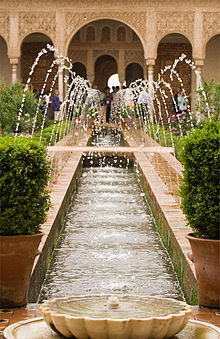User:EKCarleton/sandbox
Warning This page contains syntax errors ("cite%20note") caused by a VisualEditor bug. Do not copy/move content from this page until the errors have been repaired. See {{Warning VisualEditor bug}} for more information. |
Examples of gardens[edit]
Many of the gardens of Islamic civilization no longer exist today. While most others may retain their forms, the original plantings have been replaced with modern ones.[23] The garden is a transient form of architectural art dependent upon the climate and the resources available to those who care for it. As previously mentioned, there was a lack of botanical accuracy on written text to properly replenish the agriculture exactly as it was from previous gardens.[10]
There is debate among historians as to what gardens ought to be considered part of the Islamic garden tradition, since it spans Asia, Europe, and Africa over centuries.[1]
Umayyad gardens[edit]
Al-Ruṣāfa: An enclosed garden at the country estate of Umayyad caliph Hishām I is believed to be the earliest example of a formal charbagh garden[2]
Abbasid gardens[edit]

Generalife, Granada
Alcazaba, Malaga

Mughal Gardens[edit]
Hammadid gardens[edit]
Beni Hammad, Algeria: Dar al-Bahr, the Lake Palace, is situated on the southern end of Beni Hammad Fort, a ruined fortified city which has remained uninhabited for 800 years. Artifacts recovered from the site attest to a high degree of civilization. During its time, it was remarked upon by visitors for the nautical spectacles enacted in its large pool. Surrounding the pool and the palace were terraces, courtyards and gardens. Little is known of the details of these gardens, other than the lion motifs carved in their stone fountains. Beni Hammad Fort is a UNESCO World Heritage Site, noted as an "authentic picture of a fortified Muslim city."[3]
Ottoman gardens[edit]
Berat and Elbasan, Albania: Evliya Çelebi's 17th century CE Seyahatname (travel book) contains descriptions of Paradise Gardens around the towns of Berat and Elbasan, Albania. According to Dr. Robert Elsie, an expert on Albanian culture, very few traces of the refined oriental culture of the Ottoman era remain here today. Çelebi describes the town of Berat as an open town with "well built and attractive houses with gardens", "spread over seven verdant hills and valleys. Among them are over 100 splendid mansions with cisterns and fountains". Çelebi similarly describes the town of Elbasan as having "prosperous and cheerful-looking mansions ... adorned with beautiful vineyards, paradisiacal gardens and parks with their pavilions and galleries ... Each of them has a source of pure flowing water, a pool and a fountain with water spurting from jets. They are luxurious dwellings like those in the gardens of paradise."[4]
Safavid Gardens[edit]
Shah-Gul Garden, Tabriz
This garden, also called the "Royal Basin," is built by one of the wealth families or ruling class in Iran during the Qajar period. It was built in 1785, a period when Tabriz became a popular location for upper class in Iran to build their own country estates. The whole place is centered around a square lake about 11acres. On the south side of the lake, fruit trees surround it, and seven risen stepped terraces originate from these rows of trees. A modern pavilion was built on an eighteenth-century platform at the center of the lake. This garden is one of the few gardens still surviving in Tabriz. [3]
Qajar Gardens[edit]
Chihil Situn, Isfahan
Modern gardens[edit]
Al-Azhar Park, Cairo
Common plants found in Islamic gardens[1][edit]
- Hollyhock (Althaea)
- Pineapple (Ananas comosus)
- Jackfruit (Artocarpus integrifolia)
- Quince (Cydonia oblonga)
- Hibiscus (Hibiscus rosa sinensis)
- Hyacinth (Hyacinthus)
- Iris (Iris)
- Jasmine (Jasminum auriculatum)
- Apple (Malus)
- Oleander (Nerium)
- Lotus (Nymphaea)
- Date palm (Phoenix dactilifera)
- Apricot (Prunus armenaica)
- Pomegranate (Punica granatum)
- Rose (Rosa glandifulera)
- ^ a b Jellicoe, Susan (1976). The Islamic Garden. Dumbarton Oaks.
- ^ Ruggles, D. Fairchild. “Gardens.” Encyclopaedia of Islam, 3rd ed., 2007.
- ^ Ruggles, D. Fairchild. Islamic Gardens and Landscapes. University of Pennsylvania Press, 2008, p. 165.
- ^ Elsie, Robert. "Texts and Documents of Albanian History". Albanian History. Archived from the original on 5 July 2011. Retrieved 3 February 2018.
Extracts from: Robert Dankoff and Robert Elsie (ed.): Evliya Çelebi in Albania and Adjacent Regions (Kosovo, Montenegro, Ohrid), Leiden 2000, p. 101 127, 161 193. Translated from the Ottoman Turkish by Robert Elsie and Robert Dankoff. Also published in R. Elsie: Early Albania, a Reader of Historical Texts, 11th - 17th Centuries, Wiesbaden 2003, pp. 195-218.
